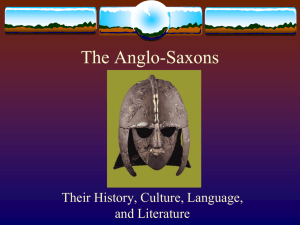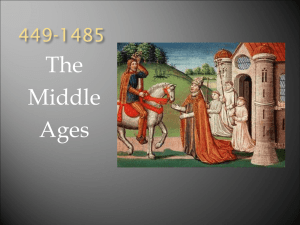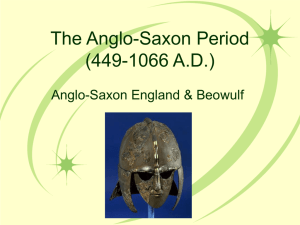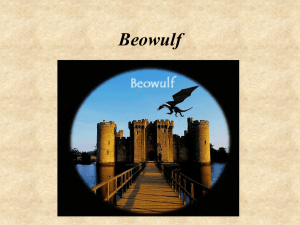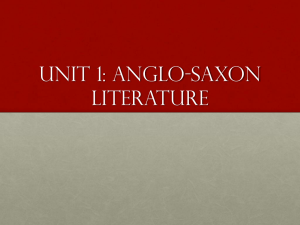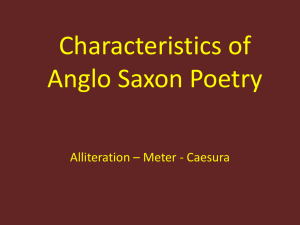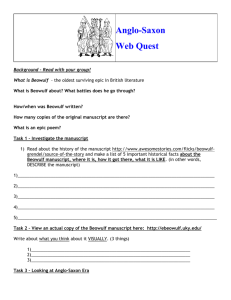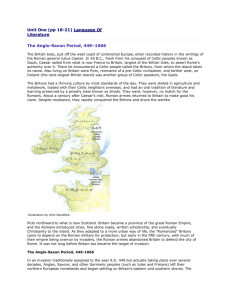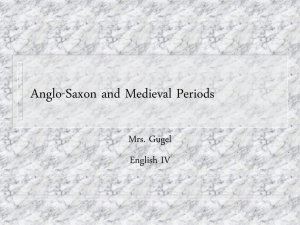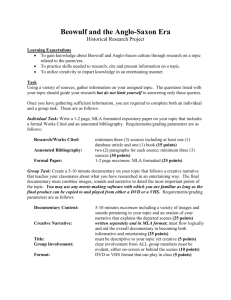Anglo-Saxon Intro PPt updated
advertisement
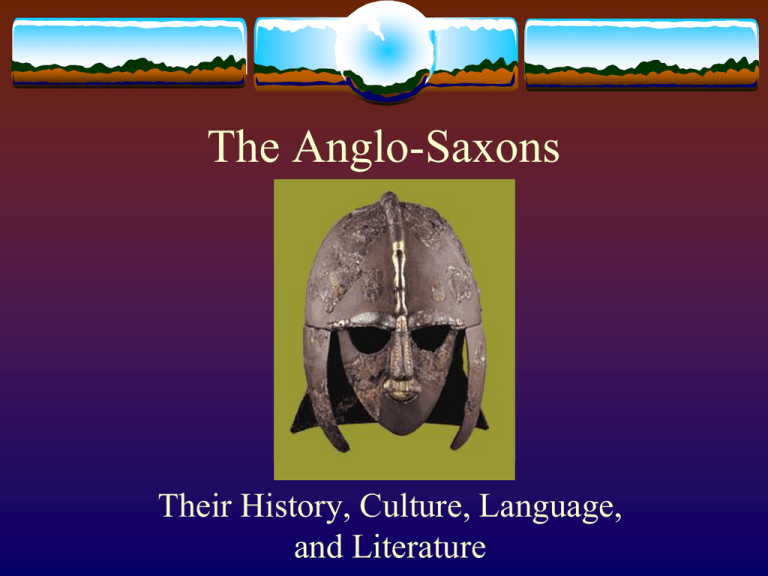
The Anglo-Saxons Their History, Culture, Language, and Literature Unit Objectives and Skills CCSS.ELA-Literacy.RL.12.3 Analyze the impact of the author’s choices regarding how to develop and relate elements of a story or drama (e.g., where a story is set, how the action is ordered, how the characters are introduced and developed). CCSS.ELA-Literacy.RL12.5 Analyze how an author’s choices concerning how to structure specific parts of a text (e.g., the choice of where to begin or end a story, the choice to provide a comedic or tragic resolution) contribute to its overall structure and meaning as well as its aesthetic impact. Characterization – epic hero Narrator bias Author’s purpose Author’s Choice: Structure/Setting/Characterizat ion Tone Point of View Overview of Historical Events Ancient Britain Roman Britain Coming of the Anglo-Saxons – The English language begins Anglo-Saxon Culture, Religion, and Social Order Beginning of the literary tradition Second Viking invasion Ancient Britain 2000 - 43 A.D. Inhabited by Britons and Celtic people Farmers and hunters Society organized into clans Ruled by tribal chieftains elected from the class of pagan priests, known as the Druids Roman Britain 43 – 449 A.D. 43 A.D. – Romans, under Claudius’s rule, conquer Britain. Brought their law, culture, comforts, and Latin language to the land. The Celts become “Romanized,” tribal disputes stop, and things are fairly peaceful. Britons were converted to Christianity with the rest of the Roman Empire in the 4th century. 5th century – Roman occupation ends. Arrival of the Anglo – Saxons 5th Century A.D. Withdrawal of the Romans left the native Britons vulnerable. Next 100 years – Britons were invaded by seafaring, Germanic invaders. Three tribes known as Angles, Saxons, and Jutes. Invasion forced natives to retreat to Wales. Old English Period begins in 449. Anglo-Saxon Occupational Areas Angles- Northern and Midland Sections – Northumbria, Mercia, East Anglia Saxons- Southern sections – Wessex, Essex, Sussex Jutes- Southeastern Province, which became the kingdom of Kent Return Anglo-Saxon Culture A.S. brought legends about ancient German heroes and kings. Warriors were celebrated in lays or songs sung at feasts by a gleeman or scop. Lays accompanied by the harp or lyre. Songs composed orally – for entertainment, but also kept history alive. Kings would entertain friends in mead halls, named for the drink mead made from fermented honey. Anglo-Saxon Religious Beliefs (Before Christianity) A.S. were Pagans. Christianity of Roman times kept alive only in remote regions. Every human life in the hands of fate. Worshipped ancient Norse gods: Tiu, god of war and the sky; Woden (Odin), chief of the gods; and Fria (Freya), Woden’s wife. Tuesday, Wednesday, and Friday the Irish – which had their own Celtic pantheon. Except Anglo-Saxon Society Organized into a class of warriors known as earls or thanes. These warriors protected and were devoted to the king, who was chosen by a witancouncil of elders. There was also a class of freemen known as churls. Slaves were known as thralls. Women, as “peace-weavers” Return of Christianity All of England converted to Christianity upon the arrival of Augustine in 597 A.D. Augustine began by converting King Ethelbert of Kent. Rest of England soon followed. Monasteries built. By 731 A.D.-Christianity well-rooted The Scribes In monasteries, scribes produced books by hand. Books were usually religious in nature. Focused on saints’ lives and sermons. There were also copies of the oral literature. Because of these Christian scribes, Anglo-Saxon culture was recorded. “Father of English History” – the Venerable Bede, a Northumbrian monk. The Danish Invasion Vikings (warriors) carried their piracy to the British Isles, bringing destruction and fear. Despite England’s efforts to defend itself, most of northern, eastern, and southern England fell to the Danes by the middle of the ninth century. Only the Saxon kingdom of Wessex fought the Danes to a standstill. Anglo-Saxon Literary Themes Heroism and kingship – the relationship between kings and their thanes (warriors). Wergild- “man price” or retribution for the death of one’s family member. After the arrival of Christianity, their relationship with God takes on these themes. Wyrd- “Fate” controlled one’s destiny. Exile- the cost of being abandoned or apart from one’s tribe and society. Weapons of War A Typical Village Beowulf Archetypal Anglo-Saxon literary work and as a cornerstone of modern literature, Beowulf Beowulf was composed by an unknown Anglo-Saxon poet around 700 A.D., but much of its material had been in circulation in oral narrative for many years. Elements of the Beowulf story—including its setting and characters—date back to the pe The action of the poem takes place around 500 A.D.Many of the characters in the poem—the Swedish and Danish royal family members, for example—correspond to actual historical figures.riod before the A-S migration. Beowulf cont. Though still an old pagan story, Beowulf thus came to be told by a Christian poet. The Beowulf poet is often at pains to attribute Christian thoughts and motives to his characters, who frequently behave in distinctly un-Christian ways. The Beowulf that we read today is therefore probably quite unlike the Beowulf with which the first Anglo-Saxon audiences were familiar. The world thatBeowulf depicts and the heroic code of honor that defines much of the story is a relic of pre–Anglo-Saxon culture. Heorot – The Meadhall in Beowulf
